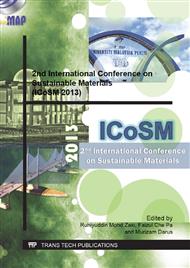[1]
I. Villaescusa, N. Fiol, M. Martinez, N. Miralles, J. Poch, J. Serarols, Removal of copper and nickel ions from aqueous solutions by grape stalks wastes, Water Res. 38 (2004) 992–1002.
DOI: 10.1016/j.watres.2003.10.040
Google Scholar
[2]
T. Akar, S. Tunali, Biosorption characteristics of Aspergillus Flavus biomass for removal of Pb(II) and Cu(II) ions from an aqueous solution, Bioresour. Technol. 97 (2006) 1780-1787.
DOI: 10.1016/j.biortech.2005.09.009
Google Scholar
[3]
A. Witek-Krowiak, R.G. Szafran, S. Modelski, Biosorption of heavy metals from aqueous solutions onto peanut shell as a low-cost biosorbent, J. Desalination. 265 (2011) 126-134.
DOI: 10.1016/j.desal.2010.07.042
Google Scholar
[4]
A. Sonune, R. Ghate, Developments in wastewater treatment methods, Desalination. 167 (2004) 55-63.
DOI: 10.1016/j.desal.2004.06.113
Google Scholar
[5]
J. Febrianto, A.N. Kosasih, J. Sunarso, Y-S. Ju, N. Indraswati, S. Ismadji, Equilibrium and kinetic studies in adsorption of heavy metals using biosorbent: A summary of recent studies. J. Hazard. Mater. 162 (2009) 616–645.
DOI: 10.1016/j.jhazmat.2008.06.042
Google Scholar
[6]
R. Nadeem, T.M. Ansari, A.M. Khalid, Fourier transform infrared spectroscopic characterization and optimum of Pb(II) biosorption by fish (Labeo Rohita) scales, J. Hazard. Mater. 156 (2008) 64-73.
DOI: 10.1016/j.jhazmat.2007.11.124
Google Scholar
[7]
M.S. Rahaman, A. Basu, M.R. Islam, The removal of As(III) and As(V) from aqueous solutions by waste materials, Bioresour. Technol. 99 (2008) 2815-2823.
DOI: 10.1016/j.biortech.2007.06.038
Google Scholar
[8]
K. Srividya, K. Mohanty, Biosorption of hexavalent chromium from aqueous solution by catla catla scales: Equilibrium and kinetics studies, Chem. Eng. J. 155 (2009) 666-673.
DOI: 10.1016/j.cej.2009.08.024
Google Scholar
[9]
H.E. Amjad, A.S. Jamal, Sorption of trace metals on fish scales and application for lead and cadmium pre-concentration with flame atomic absorption determination, Jordan J. Chem. 3 (2008) 87-97.
Google Scholar
[10]
L.P. Pavia, G.M. Lampman, G.S. Kriz, Introduction to Spectroscopy, Brooks Cole, 1996, pp.13-82.
Google Scholar
[11]
S.S. Baral, S.N. Das, P. Rath, Hexavalent chromium removal from aqueous solution by adsorption on treated sawdust, Biochem. Eng. J. 3 (2006) 216–222.
DOI: 10.1016/j.bej.2006.08.003
Google Scholar
[12]
G. Bayramoglu, A. Denizli, S. Bektas, M.Y. Arica, Entrapment of Lentinus sajor-caju into Ca-alginate gel beads for removal of Cd(II) ions from aqueous solution: Preparation and biosorption kinetics analysis, Microchem. J. 72 (2002) 63–76.
DOI: 10.1016/s0026-265x(01)00151-5
Google Scholar
[13]
Y. Sag, D. Ozerb, T. Kutsal, A comparative study of the biosorption of lead(II) to Z.Ramigera and R.Arrhizus, Process Biochem. 30 (1995) 169-174.
DOI: 10.1016/0032-9592(95)95716-v
Google Scholar
[14]
B. Yu, Y. Zhang, A. Shukla, S.S. Shukla, K.L. Dorris, The removal of heavy metal from aqueous solutions by sawdust adsorption-Removal of copper, J. Hazard. Mater. B80 (2000) 33–42.
DOI: 10.1016/s0304-3894(00)00278-8
Google Scholar
[15]
E. Romera, F. Gonzalez, A. Ballester, M.L. Blazquez, J.A. Munoz, Comparative study of biosorption of heavy metals using different types of algae, Bioresour. Technol. 98 (2007) 3344–3353.
DOI: 10.1016/j.biortech.2006.09.026
Google Scholar
[16]
V.C. Srivastava, I.D. Mall, I.M. Mishra, Equilibrium modelling of single and binary adsorption of cadmium and nickel onto bagasse fly ash, Chemical Engineering Journal. 117 (2006) 79–91.
DOI: 10.1016/j.cej.2005.11.021
Google Scholar
[17]
E. Huang, Use of fish scales as biosorbent for the removal of copper in water, Water Res. 30 (2007) 1985-1990.
Google Scholar


